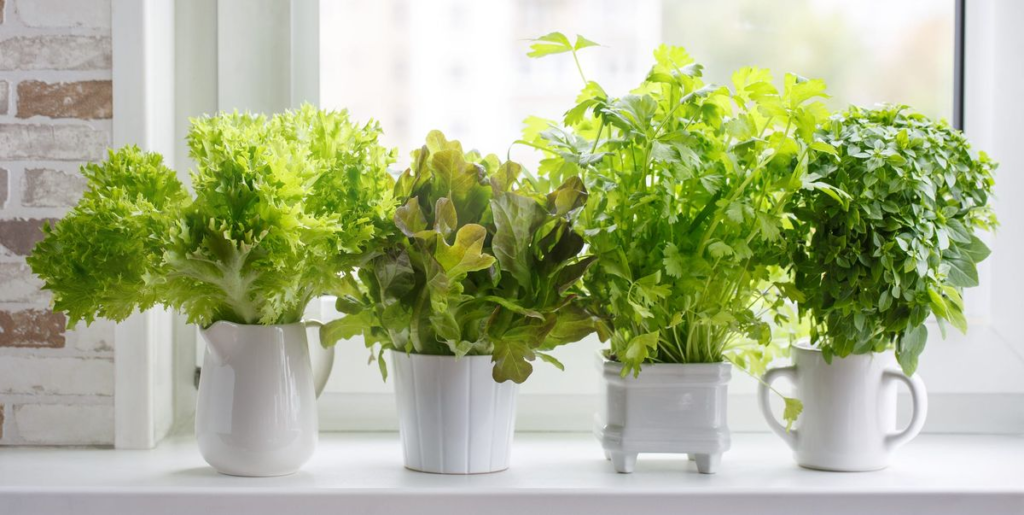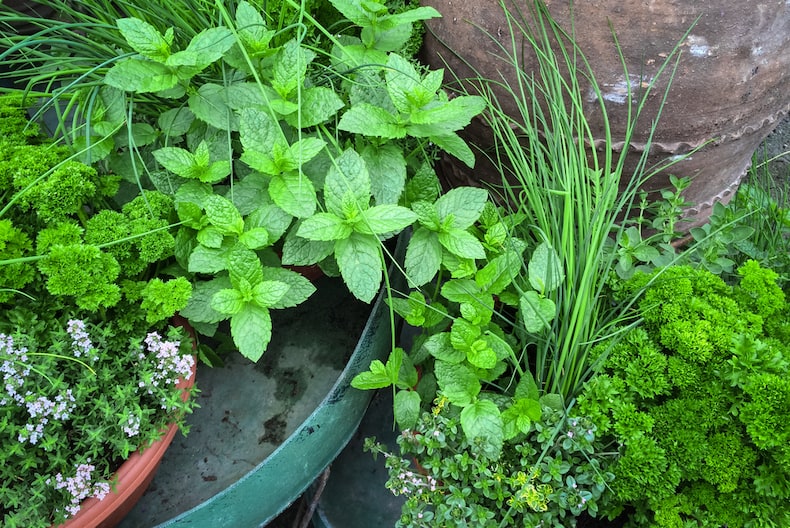Growing herbs in your kitchen year-round can be a convenient way to have fresh, flavorful ingredients at your fingertips for cooking. Here are some herbs that are well-suited for indoor cultivation and can thrive throughout the year:
- Basil (Ocimum basilicum): Basil is a popular kitchen herb known for its aromatic leaves. It can be grown indoors as long as it receives adequate sunlight. Pinch off the flowers to encourage bushier growth.
- Parsley (Petroselinum crispum): Both curly and flat-leaf (Italian) parsley can be grown indoors. They are versatile herbs used in a wide range of dishes.
- Chives (Allium schoenoprasum): Chives are easy to grow indoors and have a mild onion flavor. They can be used in salads, omelets, and as a garnish.
- Thyme (Thymus vulgaris): Thyme is a hardy herb that’s well-suited for indoor cultivation. It’s a great addition to a variety of savory dishes.
- Mint (Mentha spp.): Mint is a prolific grower, and many varieties, such as spearmint and peppermint, can be grown indoors. It’s ideal for teas and desserts.
- Oregano (Origanum vulgare): Oregano is a flavorful herb that complements Italian and Mediterranean cuisine. It grows well in pots and can be kept indoors year-round.
- Rosemary (Rosmarinus officinalis): Rosemary is a woody herb with a strong flavor. It can be grown indoors, but it prefers a lot of sunlight.
- Cilantro (Coriandrum sativum): Cilantro is a popular herb used in various cuisines, including Mexican and Thai. It can be grown indoors if provided with proper care.
- Lemongrass (Cymbopogon citratus): Lemongrass can be grown indoors in a well-lit area. It’s often used in Asian cooking and for making teas.
- Sage (Salvia officinalis): Sage is a hardy herb that can be grown indoors with the right conditions. It’s commonly used in stuffing and with poultry dishes.
Contents
To successfully grow these herbs indoors year-round, consider the following tips:
- Light: Herbs need plenty of light, so place them in a sunny windowsill or use grow lights to provide adequate light if natural sunlight is limited.
- Temperature: Maintain a consistent indoor temperature that’s suitable for the particular herbs you’re growing. Most common kitchen herbs prefer temperatures between 60-70°F (15-24°C).
- Soil: Use a well-draining potting mix in suitable containers with good drainage. Ensure the pots have saucers to catch excess water.
- Watering: Keep the soil consistently moist but not waterlogged. Allow the top inch of the soil to dry out between waterings.
- Fertilization: Feed your indoor herbs with a balanced liquid fertilizer every 4-6 weeks during the growing season.
- Pruning: Regularly prune your herbs to encourage bushier growth and prevent legginess.
- Pest Control: Keep an eye out for pests and take measures to control them if needed.
By following these guidelines and selecting the right herbs for your indoor space, you can enjoy fresh, homegrown herbs year-round for your culinary adventures.
Especially in winter, indoor herb gardens provide welcome greenery and scents in any home and especially in the kitchen. Even if you have little experience with plants or limited space, you can easily bring herbs indoors.
Some herbs are better suited for growing indoors than others. These include parsley, basil, sage and thyme. They spice up tasty stews, casseroles and roasts, and not just in winter.
The right location

A place with sufficient fluorescent light should be found. This can be a table, the kitchen counter, a shelf or even the wall. For the plant, the right light is food. Six hours of bright daylight should be seen by the herb plants in their place, and in no case should be placed in a place strongly affected by drafts. In summer, they can be placed in a sunny or even shady place on the windowsill.
Selection of the planter
Fully grown plants are better for beginners than seeds that have yet to grow any. Make sure the planter you choose has drainage holes at the bottom and is deep enough overall to encourage proper root development. The plant should never be left in the wet, as this could cause the roots to start rotting.
You can plant multiple herbs in the kitchen in one container or select individual pots for each herb plant. Overcrowded pots can lead to fungus, so make sure to space them out a bit when planting. Fertilize herbs once a month with an organic fertilizer.
Potting soil is filled into the container, and then the plant is placed on top. Potting soil is also added around it and pressed firmly. At the top of the edge should remain about 3 cm free, so that when watering nothing runs beside it. The herb garden in the house becomes really lush with this vertical garden on three levels:
Automatic herb station
If you don’t have a green thumb, I recommend a practical lighting and watering station like this one. With “Click & Grow” no daily watering or even fertilizing is necessary, the water tank only needs to be filled every three to six weeks
Plant soil with air holes was developed using nanotechnology. Built-in growth LED lamp, this promotes plant growth at an early stage and regulates itself. This station here comes with three pots of basil:


